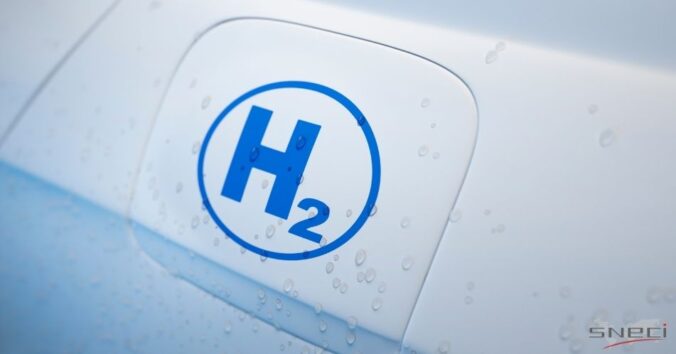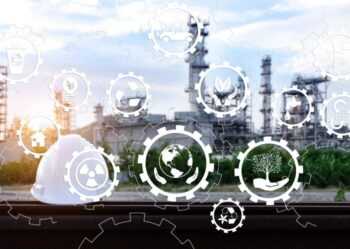France and the hydrogen deployment plan

Hydrogen, known for its properties in the petroleum and chemical industries, has major energy interest for the 21st century. Today little exploited, it brings solutions for energy production, its massive storage but also mobility.
It has many advantages, particularly in economic and environmental terms. The decarbonized production due to the technological progress of electrolysis offers a great compatibility with the objectives of France concerning the emissions of greenhouse gases, pollutants and the reduction of fossil energy consumption.
These objectives, which come from the law on energy transition for green growth, are to increase the rate of renewable energies in final energy consumption to 32% and the rate of renewable energies in electricity production to 40%.
The energy transition law also requires the reduction of fossil fuel consumption by 30% in 2030 and the decarbonization of 10% of gas.
In order to reach these objectives in the continuity of the energy transition towards carbon neutrality by 2050, hydrogen is a major development axis.
This plan is based on the French industry’s capacity to produce hydrogen, but also its excellence and competence in developing economically profitable uses that are compatible with environmental objectives, in particular for captive fleets but also for the storage of renewable energy in the gas network.
Perfectly suited to the government strategy and the PPE (Programmation Pluriannuelle de l’Energie) for the period 2019-2028, this plan also integrates the PPE carried out for areas not interconnected to the metropolitan network.
Today, several territories are identified as priorities for experimentation and development in the field of storage, particularly hydrogen; in relation to the objective of energy autonomy in 2030 in non-interconnected areas (ZNI) and strong needs for network flexibility.
What is hydrogen and its challenge?
Of all the chemical elements, hydrogen is the simplest, its atom consists only of a proton and an electron. It is the smallest chemical element also the most abundant element in the universe, 75% in mass and 92% in number of atoms, it is the main component of stars and particularly that of the sun. Known to be an energy carrier, hydrogen allows energy to be transported from point A to point B.
The only problem is that it does not exist in its pure state on earth.
This is why, on the industrial level, there are different forms of hydrogen.
Grey hydrogen comes from fossil fuels, hydrocarbons, coal and/or natural gas.
In the case of gas, it is converted via a steam reforming process. The production of grey hydrogen is polluting, emitting CO2, but is still widespread for petroleum refining, or the production of ammonia and fertilizers.
Then there is “blue” hydrogen, produced in the same way as grey hydrogen but with a CO2 capture system that can be reused or stored. It is considered today as an emerging manufacturing process.
And finally, green hydrogen, considered as “clean” because it is produced from renewable energies.
The problem is that 95% of hydrogen is currently produced from polluting fossil fuels.
How to produce hydrogen?
Hydrogen can be obtained through two processes:
- Reforming (or vaporization) – Today about 95% of dihydrogen is produced from fossil fuels by reforming. This process is widely used to produce hydrogen. This chemical reaction breaks hydrocarbon molecules under the action of heat (between 700°C and 1100°C) to release dihydrogen. Unfortunately, this form of production contributes to global warming because it releases carbon dioxide (CO2), the main gas responsible for the greenhouse effect.
- Electrolysis – An electric current is injected into the water, causing a dissociation of the atoms between the oxygen and the two hydrogen atoms: this is the dihydrogen, which will be recovered.
Hydrogen: an energy like no other
Consuming energy without directly emitting greenhouse gases is one of the advantages of using hydrogen. Its chemical properties offer a major energetic interest since it offers the possibility, after being produced, to be stored, transported and used.
The energy contained in hydrogen can be recovered in two ways: by burning it or by a fuel cell.
As an energy carrier that can now be exploited, hydrogen can be used in many other ways:
- The combustion of hydrogen generates a large amount of energy that can be used to produce heat or electricity
- The H2 molecule of dihydrogen can be produced from renewable energies, thus reducing greenhouse gas emissions.
- The combustion of hydrogen is totally decarbonated, and thus becomes an alternative to fossil fuels that emit CO2.
- Hydrogen cylinders can be easily stored and are a massive and efficient energy storage solution.
Even if the use of hydrogen has many advantages, it still requires some innovations to overcome the following problems:
- The production of hydrogen requires too much energy, (especially for its decarbonized production);
- Its storage requires a large amount of energy for its compression;
- The costs of this type of production are high and require significant investments;
- Because of its flammability, hydrogen requires precautions to be taken when using it.
All these problems show that the use of hydrogen still requires many investments so that its yields are appreciable and really advantageous.
Hydrogen can be used for multiple purposes: converted into electricity, heat or kinetic energy.
Its use is possible for stationary, industrial and mobile applications, i.e. it can be used as a chemical compound, as a driving force or as electricity.
However, its transformation requires an energy converter, commonly called “the hydrogen fuel cell”.
Hydrogen in France
As we saw, the usable energy contained in hydrogen comes from its production and storage.
There are 2 ways to recover this energy:
- Either by burning it, and in this case the combustion releases 3 x more energy than gasoline for an equivalent consumption weight.
- Or thanks to a fuel cell which produces electricity after a supply of air to H2 in the cell.
For these two modes of production, the waste rejected is only water.
The modes of production allow different exploitations:
- Mixed with methane in a gas network to produce heat, as fuel in an electric vehicle via a fuel cell, on the electrical network.
- On the other hand, the chemical properties of hydrogen make it possible to use it in the hydrocarbon refining, fertilizer production and chemical sectors.
- It can also be used as a raw material mixed with CO2 from the production of synthetic methane, and used as a gas, identical to natural gas.
Today, hydrogen has become an essentially industrial market and is a product used in both the oil and chemical industries: it is estimated at 60 Mt worldwide and at nearly 1 Mt in the French market. Hydrogen production in France amounts to 900,000 tons per year.
Between them, the desulfurization of petroleum fuels (60%), ammonia synthesis for fertilizers (25%) and for chemicals (10%), make up the majority of the industrial market.
Hydrogen is responsible for the emission of 11.5 Mt of CO2 in France (3% of national emissions), since 94% of it is produced from fossil fuels (gas, coal, hydrocarbons).
Innovation and technological progress in electrolysis have made it possible to produce hydrogen in an economical and carbon-free way. Thus, this method allowing to separate a molecule in two without using fossil energies will bring in the long term a solution for the integration of renewable energies in the electric system.
Some industrial studies are proving the possibility of producing decarbonated, non-renewable hydrogen on a large scale from fossil methane where the CO2 emitted during its production would be captured and stored underground. The decarbonation phenomenon will be accelerated thanks to this type of hydrogen production. Consequently, this new technology will help achieve the objectives set for the reduction of greenhouse gas emissions and pollutants.
The hydrogen roadmap will be structured around the following three axes: industry, mobility and energy.
Focus on the different axes of the hydrogen plan
Hydrogen is the foundation of a virtuous economic and environmental development which deployment is divided into 3 axes with progressive stages.
Stage 1 : is a start-up phase.
The technology of hydrogen production by water electrolysis is an alternative lever for industries that consume a lot of hydrogen and whose production methods are highly emissive of greenhouse gases (refineries and chemicals). As a simple and less expensive solution due to the reduction in the cost of electrolyzers, this “decarbonized” production method will be competitive by 2035. Moreover, the possibilities of proton exchange membrane (PEMFC) and alkaline technologies are now proven.
The recent high-temperature production technology, because of its high efficiency potential, remains the most promising in terms of competitiveness. France has a good lead in this technology, which is recognized by industry.
The electrolysis sector for the production of hydrogen for industrial use is particularly supported by the public authorities in addition to the existing aid for R&D and innovation.
Stage 2 consists of developing mobility uses in addition to the battery sector.
The energy transition is focusing on increasing the use of clean mobility. In this field, hydrogen-based technologies offer very interesting developments to complement batteries, especially for heavy and long-range transport or for those requiring fast recharging times.
Stage 3 aims to introduce the use of hydrogen in natural gas networks in order to stabilize energy networks in the medium-long term. Objective 1 is to reduce the use of imported fossil fuels.
The Netherlands, but also France via the GRHYD and JUPITER 1000 experimentation projects, are even considering the possibility of replacing natural gas with hydrogen.
There are working groups with industrialists in order to define the technological and regulatory data that will allow the first injections of hydrogen into gas infrastructures, with a first release before the end of 2018.
Another medium-term development objective: to make the electrical system more flexible thanks to storage resources, particularly seasonal and during the growth phase of non-controllable and non-controllable renewable energies.
Finally, we can project that beyond 2035, energy networks could be stabilized thanks to the contribution of hydrogen, not only with an acceleration of injections into gas networks, but also with the first deployments of services to the electrical network in interconnected areas (ZNI). The first experiments linked to these projects show the interest and the rapid potential of hydrogen exploitation.
SNECI and the deployment of hydrogen
Aware of the importance of green hydrogen in the energy transition for all sectors, SNECI support hydrogen producers and suppliers worldwide.
We help manufacturers to produce and supply green hydrogen with a global, agile and efficient technical approach. And we accompany suppliers in their distribution and commercial development.
Our credo is performance, efficiency, cost sharing, transparency and agility !
With 70 years of experience in the industry and deep roots in the automotive industry, a complex industry of excellence, we bring our expertise to manufacturers in a wide range of sectors, from health, rail and aeronautics to energy, luxury goods, defense and mobility.
We support our customers in the deployment of green hydrogen through electrolysis installations by improving their processes and profitability while taking into account local regulatory constraints.
Our 10 subsidiaries allow us to support any industrial or supplier around the world weather they are in Africa, Asia, Europe or America.
Our support industrial performance improvement is articulated around various axes:
- Industrial diagnosis and project management
- Definition of the action plan
- Assistance in the implementation of the action plan – audits
- Consolidation through training and coaching of teams
- Outsourcing of your support functions, purchasing and logistics
Our 450 experts working in more than 50 countries are specialized in engineering and project management with a technical DNA and a local approach to guarantee the results expected by our customers. If you would like SNECI’s engineers and experts to support you, contact us.






